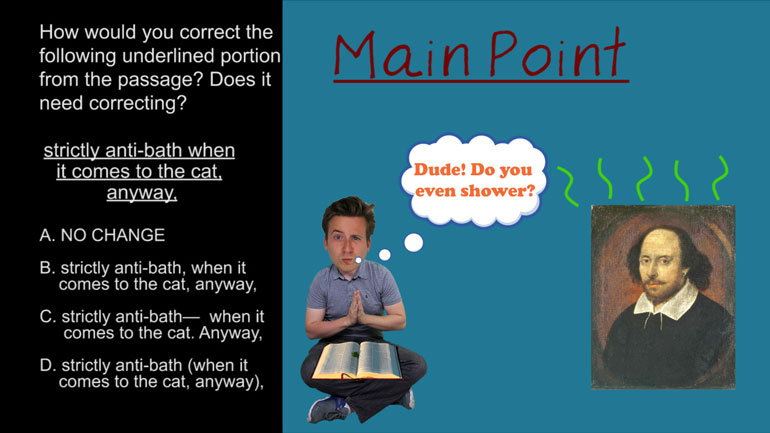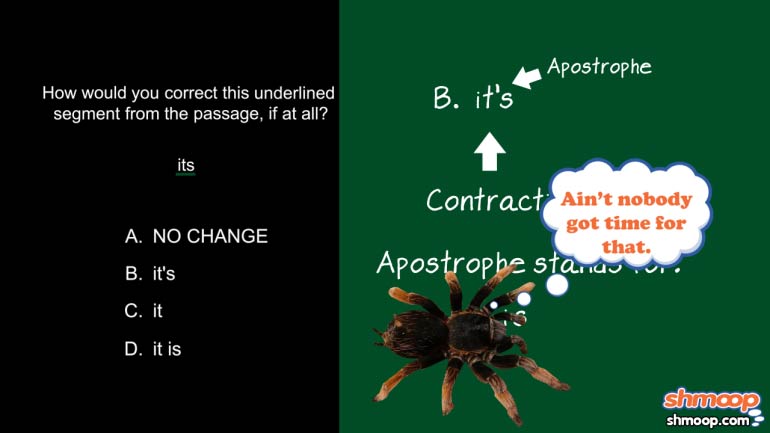ShmoopTube
Where Monty Python meets your 10th grade teacher.
Search Thousands of Shmoop Videos
Punctuation Videos 39 videos
ELA Drills, Advanced: Punctuation 1. Which option best completes the sentence?
ACT English: Punctuation Drill 1, Problem 1. Choose the correct punctuation for this sentence.
ACT English: Punctuation Drill 1, Problem 2. How should we format this list?
ACT English 2.2 Passage Drill 211 Views
Share It!
Description:
ACT English: Passage Drill 2, Problem 2. What punctuation should be used for a non-essential clause?
Transcript
- 00:03
Here’s your Shmoop du jour, brought to you by hygiene. The good, the bad, and the smelly.
- 00:09
Check out the following passage and answer the question below.
- 00:23
How would you correct the following underlined portion from the passage? Does it need correcting?
- 00:35
"When it comes to the cat, anyway" is a clause that modifies "anti-bath;"
- 00:42
it lets the reader know that the writer appreciates good hygiene, even though he or she avoids washing the cat.
Full Transcript
- 00:49
This is probably an important thing for the author to clarify on a personal level--
- 00:52
especially if he or she is on the dating scene.
- 00:56
Even if it’s an important side-note for the author, the clause is what’s known as
- 01:01
“nonessential,” meaning that it doesn’t affect the core meaning of the sentence.
- 01:05
The main point is to let the reader know the reason why the author avoids bathing the cat,
- 01:11
not to inform the reader about the writer’s bathing routines.
- 01:14
If we’re ever unsure about whether a clause is essential or nonessential,
- 01:17
we like to omit the clause and read the sentence out loud.
- 01:20
Check it: “But the most important reason why our household is strictly anti-bath
- 01:26
is because he hates taking one.” Totally works, right? Nothing super important has been lost.
- 01:32
Knowing that the clause is nonessential helps us to do some eliminating.
- 01:36
For example, we can get rid of choice (A) because it doesn’t separate the clause from the earlier part
- 01:42
of the sentence with any sort of punctuation. Marking nonessential elements this way helps
- 01:46
the reader to understand what’s most important in a sentence. Sorry, nonessential elements,
- 01:51
we know it’s not nice to single people out, but in this case it’s necessary.
- 01:55
Choice (C) is easy to cross out because it breaks up our clause all weirdly.
- 02:01
“Anyway” is essential to this nonessential clause.
- 02:04
So completely separating it with a period makes zero sense and is probably traumatic for everyone involved.
- 02:11
Choice (B) isn’t...you know...wrong wrong. It correctly separates the clause from the
- 02:15
rest of the sentence with commas, which is the most typical method of punctuating nonessential elements.
- 02:21
It also correctly places a comma before “anyway.”
- 02:24
The trouble is that the sentence now looks majorly overcrowded with commas.
- 02:30
Let’s hope there’s a better option on the table.
- 02:33
Yeah, choice (D) is the best answer.
- 02:34
It’s also OK to separate nonessential elements with parentheses.
- 02:38
This works great here because it gets the job done without turning the sentence
- 02:41
into Comma-thon 2014.
- 02:44
We went to Comma-thon 2013, and believe us, it’s way over-rated.
Related Videos
ACT English: Punctuation Drill 2, Problem 2. Where should the semi-colon be placed?
ACT English: Punctuation Drill 3, Problem 1. How should this sentence be changed so that it is grammatically correct?
ACT English: Punctuation Drill 3, Problem 2. How should we properly hyphenate the words in this sentence?
ACT English: Punctuation Drill 3, Problem 4. Which choice best formats this list of items?
ACT English: Punctuation Drill 2, Problem 1. Which choice of punctuation best completes the sentence?






































